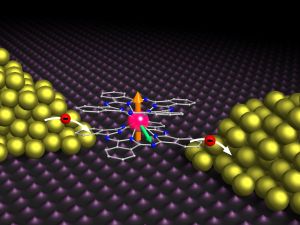Quantum computers promise to reach computation speeds far beyond that of today’s computers. As they would use quantum effects, however, they would also be susceptible to external interferences. Information flow into and out of the system is a critical point. Researchers from KIT with partners from Grenoble and Strasbourg have now read out the quantum state of an atom directly by using electrodes. In the Nature journal, it is reported about the stable interface between classical and quantum world. (DOI: 10.1038/nature11341)
“Normally, every contact with the outer world changes information in a quantum mechanical system in a completely uncontrolled manner,” explains Professor Mario Ruben from Karlsruhe Institute of Technology. “We therefore have to keep the quantum state stable and shielded. On the other hand, information has to be read out in a controlled manner for further use.”
Magnetic molecule complexes may be a solution of this dilemma. In their center, a metal atom with a pronounced magnetic moment, a spin, is located. It is surrounded by organic molecules that shield the atom. “When synthesizing this protective enclosure, we can exactly define how much the metal atom sees of the outer world,” explains Ruben the trick of his research project.
The study presented is based on the metal atom terbium that was provided with an enclosure of about 100 carbon, nitrogen, and water atoms and then placed in the center of nanometer-sized, electric gold contacts. Due to the properties of the molecule, the electrodes had an effect similar to the three channels of a transistor. Electric voltage of the middle gate electrode influenced the current through the other two electrodes. In this way, the working point was set. Then, the molecule was exposed to various changing magnetic fields and the jump of the spin was reflected by the amplitude of the current curve. “By measuring current flow, we found that the nuclear spin of the metal atom is stable for up to 20 seconds,” says Ruben. “For quantum mechanical processes, this is a very long time.”
Ruben is sure that “the results will be of particular importance to spintronics and quantum computing.” Spintronics uses the magnetic spin of single particles for information processing. The word describes the symbiosis of spin and electronics. Quantum computers use quantum mechanical effects, such as the entanglement and super-position of spins, for the parallel execution of algorithms at high speed.
The Publication:
“Electronic read-out of a single nuclear spin using a molecular spin-transistor”, R. Vincent et. al., Nature, vol. 488, issue 7411, pp 357-360, doi: 10.1038/nature11341
For further information to the topic please also read:
„Real-space observation of spin-split molecular orbitals of adsorbed single-molecule magnets" J. Schwöbel et. al. Nature Comms. 2, 2012, DOI: 10.1038/ncomms1953.
http://www.nature.com/ncomms/journal/v3/n7/full/ncomms1953.html
Being “The Research University in the Helmholtz Association”, KIT creates and imparts knowledge for the society and the environment. It is the objective to make significant contributions to the global challenges in the fields of energy, mobility, and information. For this, about 10,000 employees cooperate in a broad range of disciplines in natural sciences, engineering sciences, economics, and the humanities and social sciences. KIT prepares its 22,800 students for responsible tasks in society, industry, and science by offering research-based study programs. Innovation efforts at KIT build a bridge between important scientific findings and their application for the benefit of society, economic prosperity, and the preservation of our natural basis of life. KIT is one of the German universities of excellence.

